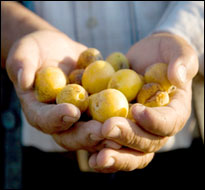The San Francisco Chronicle reported in 2012 that shortages in the agricultural labor pool left California farmers struggling to harvest their crops. The U.S. Department of Labor notes that 75% of U.S. agricultural workers are born in Mexico. But since 2007, the influx of immigrants from that country has slowed to near zero, and some attributed the 2012 labor shortage to tougher U.S. immigration policies. Another possible cause for the decline may have been Mexico’s improving economy; a 2012 U.N. report predicted that the overall economic growth rate in Mexico was on pace to reach 3.4%. In any case, the Labor Department predicts that employment for agriculture workers is expected to decline by 3% between 2010 and 2020.
A 2012 study suggests that the decrease in Mexican migrants available for U.S. farm jobs is a consequence of long-term structural changes in the supply of Mexican labor. That study, published in Applied Economic Perspectives and Policy, “The End of Farm Labor Abundance,” analyzes the pool of available agricultural workers in the U.S. and Mexico over the past decade. The authors, from the University of California, Davis and El Colegio de Mexico, examined data from the Mexico National Rural Household Survey, a sample of Mexican households, in 2003, 2008, and 2011.
Key study findings include:
- Between 2007 and 2010, the number of Mexicans migrating to engage in agriculture work in both internally within Mexico and into the United States decreased. The researchers state that this decrease was not related to the economic recession at the time.
- “The shift in labor supply from farm to non-farm work in Mexico is consistent with global economic trends. Worldwide, as incomes rise, the share of the labor force working in agriculture is decreasing…. Economic growth and rising agricultural productivity in Mexico have increased job opportunities and reservation wages for rural Mexican workers.”
- The Mexican workforce is shifting away from farm work while the demand for agricultural labor in Mexico is on the rise. The authors conclude that American farms will be competing with Mexican farms for laborers in the near future.
- “The number of international migrants [to the United States] increased in the years leading up to the recession between 2002 and 2007; however, between 2007 and 2010, with the onset of the recession, there was a sharp decrease in international migration. Internal migration, on the other hand, grew substantially for both the farm and non-farm sectors from 2002-2007, as well as 2007-2010. These data reveal that migration from Mexico to the United States fell dramatically after the 2008 recession, and many former immigrants found work in Mexico.”
- Between 2008 and 2009, the number of workers on U.S. farms remained steady at 2.1 to 2.3 million, while the number of rural Mexicans migrating to work on U.S. farms decreased substantially. The authors argue that this decrease is due to structural changes in the supply of Mexican labor, rather than a temporary response to the recession.
The authors conclude that “perceived labor shortages and rising real farm wages create incentives to change both crop choices and production and management methods.” In a related study, The U.S. Department of Labor’s Occupational Outlook Handbook predicts a decline of 20,000 agricultural jobs from 2010 to 2020.
Tags: Latino, Hispanic, California, organized labor, rural


Expert Commentary